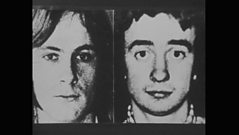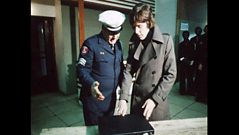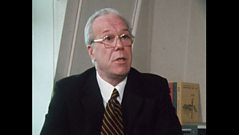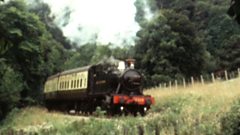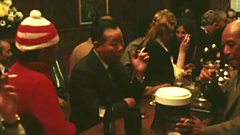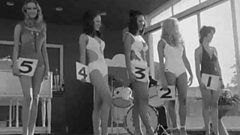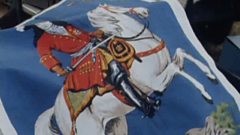
Alleged bomb factory
Reporter John Stapleton visits Third Avenue Harlesden where the Maguire family once lived. He describes the activities that took place in ‘Auntie Annie’s Devil’s Kitchen’.
Reporter John Stapleton is seen crossing the road and standing outside the Maguire family’s house in Third Avenue, Harlesden.
Stapleton warns viewers about the danger posed by terrorists living undercover, “Sleepers are people in streets like this; it might be your street, or the one next to you”. These are people who have lived in Britain for a long time and have therefore become accepted members of the community – arousing no suspicion. Stapleton contends that the most notorious of all sleepers was Anne Maguire.
He describes how Anne Maguire seemed like an ordinary housewife.
“Auntie Annie, as she was known to her terrorist friends, was a vital cog in the bombers’ machine.”
Stapleton states that Anne Maguire trained new recruits how to make bombs; she also stored explosives in her kitchen.
Only one neighbour had suspicions about Anne Maguire – none of the neighbours would speak to John Stapleton on camera, “They are, they say, too scared.”
Bob Huntley, former Commander of the Bomb Squad, advises people to take note of when neighbours come and go from their homes.
CONTEXT
On 5 October 1974 the Provisional Irish Republican Army (PIRA) targeted Guildford, Surrey, because it was situated close to a number of garrison towns. The PIRA planted two six-pound gelignite bombs in two pubs. The first exploded just before 9.00pm in the Horse and Groom, destroying the front of the building and shattering the windows of neighbouring shops.
It killed Paul Craig, a plasterer (22 years old); two members of the Scots Guards, William Forsyth (18) and John Hunter (17); and two members of the Women’s Royal Army Corps, Caroline Jean Slater (18) and Ann Ray Hamilton (19). A further sixty-five persons were wounded.
After the first explosion, other public houses were evacuated, including the Seven Stars where the second bomb exploded at approximately 9.35 pm without causing any serious injuries.
On November 7 1974 Gunner Richard Dunne, a soldier (42) and Alan Horsley, a sales clerk (20) were killed when a PIRA bomb exploded in the King’s Arms in Woolwich. Twenty-six people, including five soldiers, were injured.
In December 1974 the police arrested three men and a woman: Gerry Conlon, Paul Hill, Patrick Armstrong and Carole Richardson. In October 1975 these four were convicted of the Guildford and Woolwich bombings and given life sentences. The group was known as the Guildford Four.
On 4 March 1976 the Maguire Seven were convicted of making the explosives used in these bombings. The Maguire Seven were: - Anne Maguire, Patrick Maguire (Anne’s husband), Patrick Maguire (son of Anne and Patrick), Vincent Maguire (son of Anne and Patrick), Sean Smyth (brother of Anne), Patrick O’Neill (family friend) and Giuseppe Conlon (brother-in-law of Anne Maguire and father of Gerry Conlon).
Over the years, the cases of the Guildford Four and the Maguire Seven came under increasing legal scrutiny and the range of those seeking a review of the convictions extended widely. On 17 October 1989 it was announced that corruption proceedings would be taken against the police involved in the conviction of the Guildford Four. Two days later, with the exception of Paul Hill, those convicted for the bombings were released. This followed an announcement by the Director of Public Prosecutions that it would be wrong for the Crown ‘to seek to sustain’ the convictions of 1975 on the basis of confessions that were later retracted.
The Court of Appeal had decided that the DPP in 1975 had suppressed scientific evidence which conflicted with the confessions. Paul Hill remained in custody because he was implicated in a case that had not yet been resolved. His conviction was eventually quashed in April 1994.
On 26 June 1991 the Court of Appeal overturned the sentences on the Maguire Seven – all of whom had completed their sentences.
Afterwards many criticised the court for dismissing most of the grounds of appeal and for simply concluding that the hands of the convicted could have been innocently contaminated with nitro-glycerine.
Duration:
This clip is from
More clips from 02/04/1976
-
![]()
Paul Hill and Gerry Conlon
Duration: 03:22
-
![]()
Bombing of the 1976 Ideal Home Exhibition
Duration: 03:38
-
![]()
Terrorists in London
Duration: 02:13
-
![]()
The continuing danger from PIRA bombs
Duration: 01:43
More clips from Nationwide
-
![]()
A Passion for Steam Trains—23/09/1975
Duration: 10:35
-
![]()
Eddie Braben on Liverpool—10/09/1979
Duration: 13:44
-
![]()
Southend Holiday—24/08/1973
Duration: 10:25
-
![]()
Scarva—10/07/1981
Duration: 08:28

